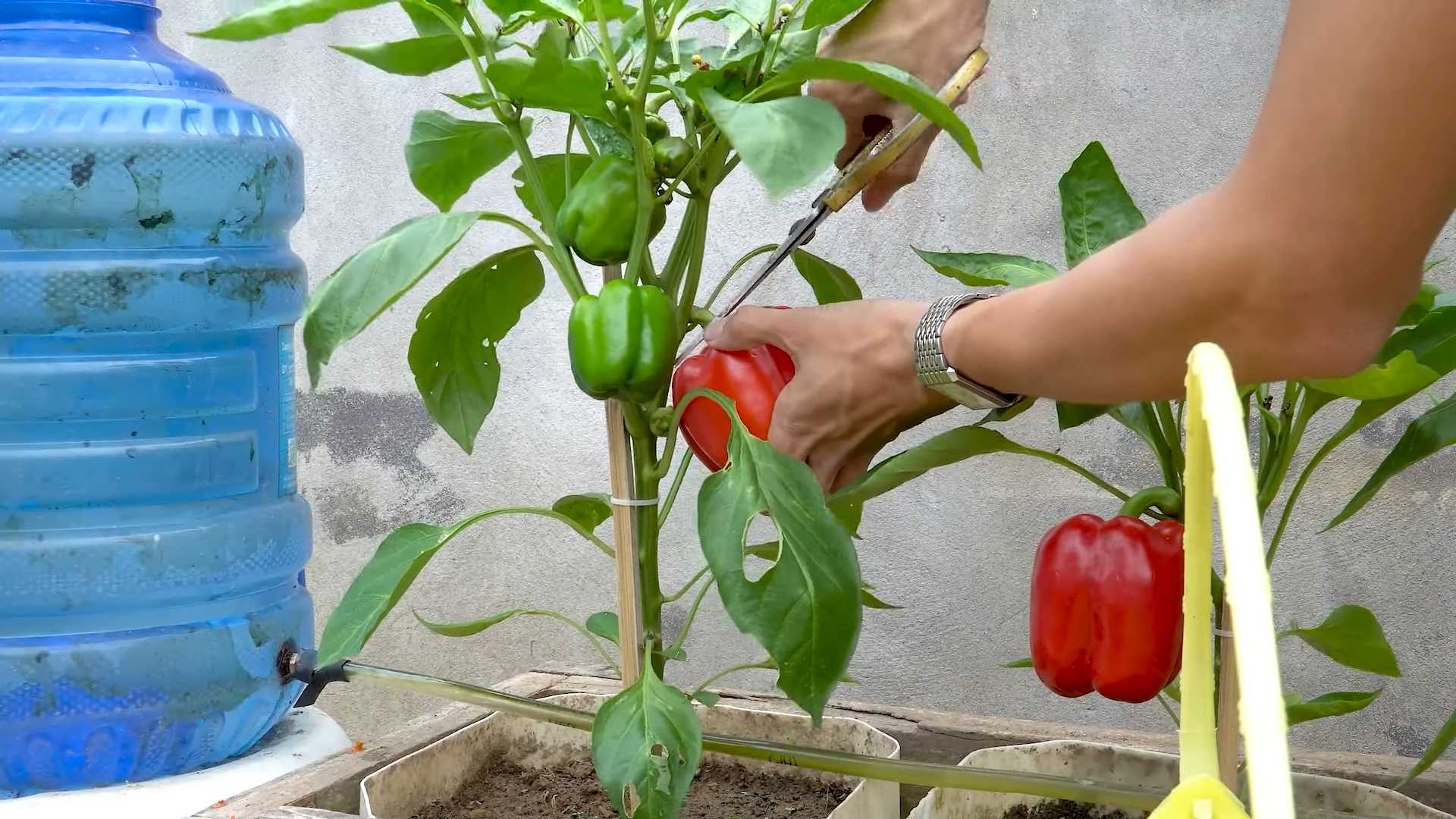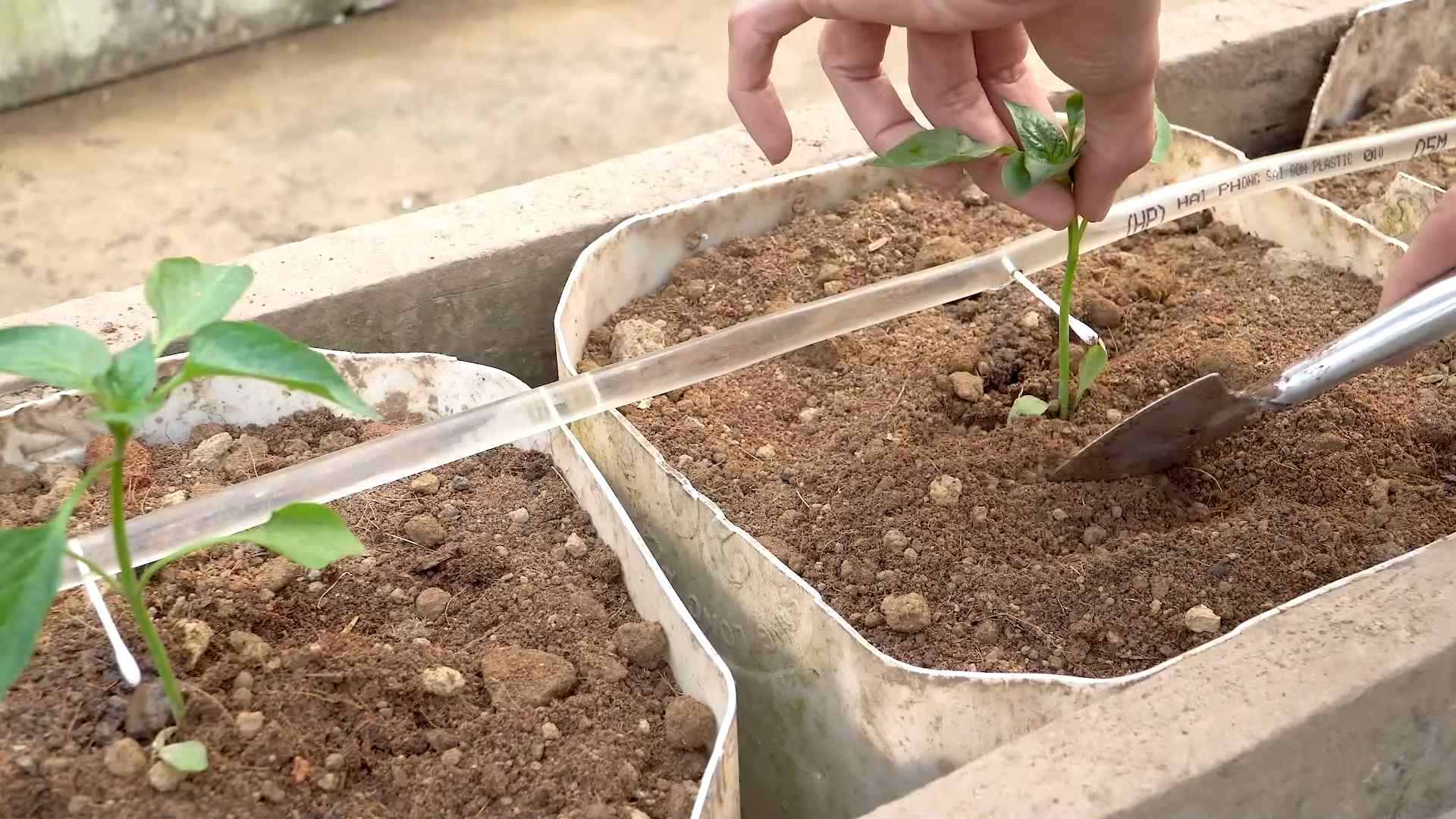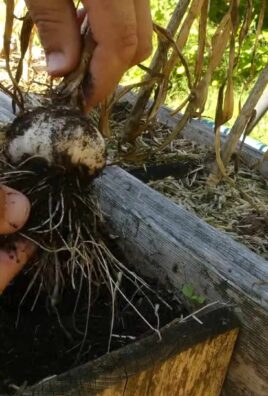Bell Pepper Container Gardening: Imagine plucking a vibrant, juicy bell pepper straight from your patio, ready to add a burst of flavor to your next meal. Sounds dreamy, right? Well, it doesn’t have to be just a dream! I’m here to tell you that growing your own bell peppers, even without a sprawling garden, is totally achievable with container gardening.
Growing bell peppers has been a part of human history for centuries, with roots tracing back to South and Central America. These colorful veggies weren’t just a food source; they held cultural significance, used in traditional medicines and rituals. Now, we can bring that rich history right to our own homes!
But why should you bother with bell pepper container gardening? In today’s world, we’re all looking for ways to connect with nature, eat healthier, and maybe even save a few bucks. Growing your own food ticks all those boxes! Plus, let’s be honest, store-bought peppers just don’t compare to the fresh, sun-ripened flavor of homegrown ones. This DIY guide will give you the tricks and hacks you need to successfully grow bell peppers in containers, no matter your experience level. I’ll walk you through everything from choosing the right container and soil to providing the perfect amount of sunlight and water. Get ready to enjoy a bountiful harvest of delicious bell peppers right at your fingertips!

Growing Bell Peppers in Containers: A Beginner’s Guide
Hey there, fellow gardening enthusiasts! I’m so excited to share my experience with growing bell peppers in containers. It’s a fantastic way to enjoy fresh, homegrown peppers even if you don’t have a sprawling backyard. Trust me, with a little know-how, you can have a vibrant pepper patch right on your patio or balcony. Let’s dive in!
Choosing the Right Bell Pepper Variety
First things first, let’s talk about pepper varieties. Not all bell peppers are created equal, especially when it comes to container gardening. You’ll want to choose varieties that are compact and well-suited for smaller spaces. Here are a few of my favorites:
* ‘Patio Baby’: As the name suggests, this variety is perfect for patios! It produces small, sweet peppers on compact plants.
* ‘Mini Bell’: These are adorable and prolific, yielding lots of bite-sized peppers. They come in various colors, adding a splash of vibrancy to your container garden.
* ‘Lunchbox’: Similar to Mini Bells, these are slightly larger and great for snacking.
* ‘Sweet Palermo’: While technically not a bell pepper (it’s a sweet pointed pepper), it grows well in containers and offers a delicious, sweet flavor.
Pro Tip: Check the plant tag or seed packet for information on plant size and suitability for containers before making your selection.
Gathering Your Supplies
Okay, now that we’ve picked our pepper varieties, let’s gather the necessary supplies. Here’s what you’ll need:
* Containers: Choose containers that are at least 12 inches in diameter and 12 inches deep. Larger is always better, as it gives the roots more room to grow. Make sure your containers have drainage holes!
* Potting Mix: Use a high-quality potting mix specifically formulated for containers. Avoid using garden soil, as it can become compacted and doesn’t drain well.
* Bell Pepper Seedlings or Seeds: You can start your peppers from seed indoors or purchase seedlings from a local nursery.
* Fertilizer: A balanced fertilizer (e.g., 10-10-10) or a fertilizer specifically formulated for vegetables will work wonders.
* Watering Can or Hose: For regular watering.
* Gardening Gloves: To keep your hands clean.
* Optional:
* Plant Markers: To label your pepper varieties.
* Stakes or Cages: To support the plants as they grow, especially for larger varieties.
* Mulch: To help retain moisture and suppress weeds.
Planting Your Bell Peppers
Alright, let’s get our hands dirty! Here’s how to plant your bell peppers in containers:
1. Prepare the Containers: Fill your containers with potting mix, leaving about an inch or two of space at the top.
2. Planting Seedlings: If you’re using seedlings, gently remove them from their nursery pots. Loosen the roots slightly, and plant each seedling in the center of a container. The top of the root ball should be level with the soil surface.
3. Planting Seeds: If you’re starting from seed, sow a few seeds per container, about 1/4 inch deep. Once the seedlings emerge, thin them out, leaving only the strongest one.
4. Water Thoroughly: After planting, water the containers thoroughly until water drains out of the drainage holes. This helps settle the soil and ensures the roots are well-hydrated.
5. Label Your Plants: Use plant markers to label each container with the pepper variety. This will help you keep track of which peppers are which.
Caring for Your Bell Peppers
Now that your bell peppers are planted, it’s time to provide them with the care they need to thrive.
1. Sunlight: Bell peppers need at least 6-8 hours of sunlight per day. Place your containers in a sunny location where they’ll receive plenty of direct sunlight.
2. Watering: Water your bell peppers regularly, especially during hot, dry weather. The soil should be consistently moist but not waterlogged. Check the soil moisture by sticking your finger into the soil. If the top inch feels dry, it’s time to water.
3. Fertilizing: Feed your bell peppers with a balanced fertilizer every 2-3 weeks. Follow the instructions on the fertilizer package for application rates. You can also use a liquid fertilizer diluted in water.
4. Support: As your bell pepper plants grow, they may need support to prevent them from toppling over. Use stakes or cages to provide support, especially for larger varieties.
5. Pruning: Pruning isn’t strictly necessary, but it can help improve air circulation and encourage bushier growth. Remove any yellowing or dead leaves. You can also pinch off the growing tips to encourage branching.
6. Pest and Disease Control: Keep an eye out for pests such as aphids, whiteflies, and spider mites. If you notice any pests, treat them with insecticidal soap or neem oil. Bell peppers can also be susceptible to diseases such as blossom end rot. To prevent blossom end rot, ensure your plants receive consistent watering and calcium.
Troubleshooting Common Problems
Even with the best care, you might encounter some challenges along the way. Here are a few common problems and how to address them:
* Blossom End Rot: This is caused by a calcium deficiency and results in a dark, sunken spot on the bottom of the pepper. Ensure consistent watering and consider adding calcium to the soil.
* Aphids: These tiny pests suck sap from the leaves, causing them to curl and distort. Spray them with insecticidal soap or neem oil.
* Whiteflies: Similar to aphids, whiteflies suck sap from the leaves. Use yellow sticky traps to catch them or spray with insecticidal soap.
* Spider Mites: These tiny pests create webs on the leaves and cause them to become speckled. Increase humidity around the plants and spray with insecticidal soap.
* Lack of Fruit Set: If your bell pepper plants are producing flowers but not setting fruit, it could be due to temperature fluctuations, lack of pollination, or nutrient deficiencies. Ensure consistent temperatures, hand-pollinate the flowers if necessary, and fertilize regularly.
Harvesting Your Bell Peppers
The moment you’ve been waiting for! Harvesting your bell peppers is the most rewarding part of the process.
1. Timing: Bell peppers are typically ready to harvest 60-80 days after transplanting. The peppers should be firm, glossy, and fully colored.
2. Harvesting Technique: Use a sharp knife or pruning shears to cut the peppers from the plant. Leave a small stem attached to the pepper.
3. Storage: Store your harvested bell peppers in the refrigerator for up to a week.
Step-by-Step Instructions Summary
To make things super clear, here’s a quick recap of the steps:
1. Choose your bell pepper variety: Opt for compact varieties like ‘Patio Baby’ or ‘Mini Bell’.
2. Gather your supplies: You’ll need containers, potting mix, seedlings or seeds, fertilizer, and watering tools.
3. Plant your bell peppers: Fill containers with potting mix, plant seedlings or seeds, and water thoroughly.
4. Provide sunlight: Ensure at least 6-8 hours of direct sunlight daily.
5. Water regularly: Keep the soil consistently moist but not waterlogged.
6. Fertilize every 2-3 weeks: Use a balanced fertilizer or one specifically for vegetables.
7. Provide support: Use stakes or cages to support the plants as they grow.
8. Monitor for pests and diseases: Treat any problems promptly with appropriate solutions.
9. Harvest when ripe: Cut the peppers from the plant when they are firm, glossy, and fully colored.
Extra Tips for Success
Here are a few extra tips to help you achieve bell pepper container gardening success:
* Rotate Your Crops: If you’re growing bell peppers in the same containers year after year, rotate your crops to prevent soilborne diseases.
* Companion Planting: Plant basil, marigolds, or nasturtiums near your bell peppers to deter pests.
* Hand-Pollination: If you’re having trouble with fruit set, try hand-pollinating the flowers. Use a small paintbrush to transfer pollen from one flower to another.
* Mulch: Add a layer of mulch around the base of the plants to help retain moisture and suppress weeds.
* Observe Your Plants: Pay close attention to your bell pepper plants and adjust your care as needed. Each plant is unique and may have different needs.
Enjoying Your Homegrown Bell Peppers
Finally, the best part – enjoying the fruits (or rather, vegetables!)

Conclusion
So, there you have it! Transforming your patio, balcony, or even a sunny windowsill into a thriving bell pepper garden is not only achievable but incredibly rewarding. This DIY container gardening method unlocks a world of fresh, flavorful bell peppers right at your fingertips, eliminating the need for extensive garden space or specialized equipment. We’ve walked you through the simple steps, from selecting the right container and soil to nurturing your plants for optimal growth.
Why is this a must-try? Because it empowers you to take control of your food source, ensuring you’re enjoying bell peppers free from harmful pesticides and bursting with homegrown goodness. Imagine the satisfaction of harvesting your own vibrant peppers, ready to be incorporated into your favorite dishes. Think of the cost savings compared to constantly buying them at the grocery store. And consider the sheer joy of watching your plants flourish under your care.
But the beauty of container gardening lies in its adaptability. Feel free to experiment with different bell pepper varieties. Try growing a mix of red, yellow, orange, and even purple peppers for a colorful and diverse harvest. You can also companion plant herbs like basil or oregano in the same container to deter pests and enhance the flavor of your peppers. For those with limited sunlight, consider investing in a grow light to supplement natural light and ensure healthy plant development. If you live in a particularly hot climate, providing afternoon shade can prevent your peppers from scorching.
Don’t be afraid to get creative! You can even repurpose old buckets, tubs, or even large plastic storage containers as planters, as long as they have adequate drainage holes. The possibilities are endless!
We’re confident that with a little effort and attention, you’ll be enjoying a bountiful harvest of delicious bell peppers in no time. This DIY bell pepper container gardening project is more than just a gardening technique; it’s an invitation to connect with nature, cultivate your own food, and experience the satisfaction of growing something beautiful and delicious.
Now, it’s your turn! We encourage you to give this DIY trick a try. Start small, learn as you go, and don’t be discouraged by initial setbacks. Gardening is a journey, and every mistake is an opportunity to learn and grow.
Most importantly, we want to hear about your experience! Share your photos, tips, and stories with us in the comments below. Let us know what varieties you’re growing, what challenges you’ve faced, and what successes you’ve celebrated. Your feedback will not only inspire others but also help us refine and improve this guide for future gardeners. So, grab your containers, soil, and bell pepper seedlings, and let’s get growing! Happy gardening!
Frequently Asked Questions (FAQ)
What is the best size container for growing bell peppers?
A good rule of thumb is to use a container that is at least 12 inches in diameter and 12 inches deep. However, larger containers (15-20 inches) are even better, as they provide more room for the roots to grow and allow for better water retention. Each bell pepper plant should have its own container of this size. Crowding multiple plants into a single small container will significantly reduce your yield.
What type of soil should I use for bell pepper container gardening?
Avoid using garden soil directly in your containers, as it can become compacted and poorly drained. Instead, opt for a high-quality potting mix that is specifically formulated for container gardening. Look for a mix that contains ingredients like peat moss, perlite, and vermiculite, which provide good drainage, aeration, and water retention. You can also amend your potting mix with compost or other organic matter to provide additional nutrients.
How often should I water my bell pepper plants in containers?
Watering frequency will depend on several factors, including the size of your container, the type of soil you’re using, the weather conditions, and the growth stage of your plant. As a general guideline, water your bell pepper plants whenever the top inch of soil feels dry to the touch. Water deeply, until water drains out of the drainage holes at the bottom of the container. Avoid overwatering, as this can lead to root rot. During hot, dry weather, you may need to water your plants daily.
How much sunlight do bell pepper plants need?
Bell pepper plants need at least 6-8 hours of direct sunlight per day to thrive. Choose a location for your containers that receives plenty of sunlight throughout the day. If you don’t have a sunny spot, you can supplement with grow lights. Insufficient sunlight will result in leggy plants with poor fruit production.
What kind of fertilizer should I use for bell pepper plants?
Bell pepper plants are heavy feeders and require regular fertilization to produce a good harvest. Use a balanced fertilizer (e.g., 10-10-10) or a fertilizer specifically formulated for vegetables. Follow the instructions on the fertilizer package for application rates and frequency. You can also supplement with organic fertilizers like compost tea or fish emulsion. Avoid over-fertilizing, as this can burn the roots of your plants.
How do I prevent pests and diseases in my bell pepper container garden?
Regularly inspect your plants for signs of pests or diseases. Common pests that affect bell peppers include aphids, spider mites, and whiteflies. You can control these pests with insecticidal soap, neem oil, or by handpicking them off the plants. To prevent diseases, ensure good air circulation around your plants and avoid overwatering. If you notice any signs of disease, such as leaf spots or wilting, remove the affected leaves or plants immediately.
When should I harvest my bell peppers?
Bell peppers can be harvested at any stage of maturity, depending on your preference. Green bell peppers are typically harvested when they are firm and fully sized, but before they begin to change color. Colored bell peppers (red, yellow, orange) are harvested when they have reached their full color and are slightly soft to the touch. Use a sharp knife or pruning shears to cut the peppers from the plant, leaving a short stem attached.
Can I grow bell peppers indoors in containers?
Yes, you can grow bell peppers indoors in containers, but you’ll need to provide them with adequate light and warmth. Place your containers in a sunny window that receives at least 6-8 hours of direct sunlight per day. If you don’t have enough natural light, you can supplement with grow lights. You’ll also need to ensure that your plants are kept warm, as bell peppers prefer temperatures between 70-80°F (21-27°C).
My bell pepper plants are flowering, but not producing fruit. What could be the problem?
There are several reasons why your bell pepper plants might be flowering but not producing fruit. One common cause is lack of pollination. Bell peppers are self-pollinating, but they sometimes need a little help. You can gently shake the plants or use a small paintbrush to transfer pollen from one flower to another. Other possible causes include insufficient sunlight, extreme temperatures, and nutrient deficiencies.
Can I overwinter my bell pepper plants in containers?
In some climates, you can overwinter your bell pepper plants in containers by bringing them indoors before the first frost. Cut back the plants to about 6 inches tall and remove any remaining fruit or leaves. Place the containers in a cool, bright location, such as a garage or basement. Water sparingly throughout the winter, allowing the soil to dry out between waterings. In the spring, gradually acclimate the plants to outdoor conditions before transplanting them back into your garden or keeping them in their containers.





Leave a Comment